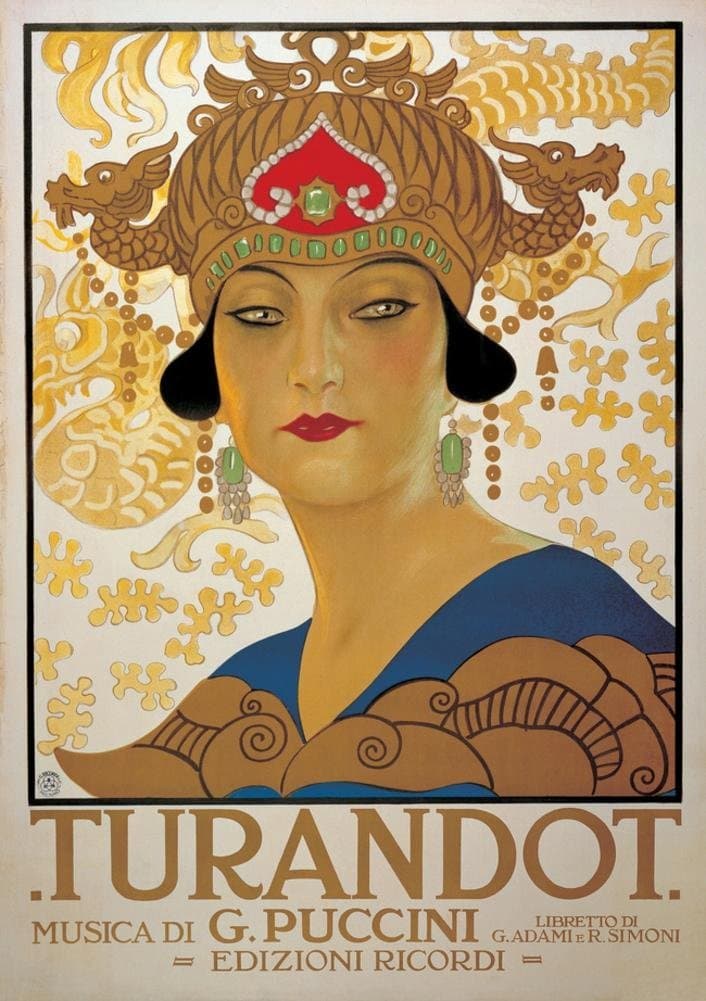Crossover and Pop Versions of the Famous Opera Aria

Poster of Puccini’s Turandot
I believe that it was Luciano Pavarotti who single-handedly made “Nessun dorma,” from Giacomo Puccini’s opera Turandot one of the most popular tunes on the planet.
“Nessun dorma”: Luciano Pavarotti
It is the story of Calaf, who wants to win the hand of the prickly Princess Turandot. He must solve three riddles, with any single wrong answer resulting in execution. Calaf manages to solve all three riddles but Turandot still refuses to marry him. So Calaf comes up with his own bizarre challenge. If the Princess is able to guess his name before dawn the next day, she may execute him. However, if she can’t guess his name correctly, she must marry him. That puts the Princess in a bit of a bind, and she declares “Nessun dorma” (None shall sleep) in the entire kingdom until Calaf’s name is discovered. If her minions are not able to come up with the correct name by morning, everybody will be executed. Calaf is rather hopeful that he will win this strange little wager, and begins to sing one of the best-known tenor arias in all of opera. And just in case you don’t remember the tune, here is Pavarotti himself.
“Nessun dorma”: Jeff Beck
Once a tune had become famous enough to cross into the world of popular music, a long line of performers adapted the music to their particular musical style. And that is certainly the case with legendary guitarist Jeff Beck, who sadly passed away only a couple of days ago. He shot to fame with the Yardbirds and led the Jeff Beck Group, and famously, his fingers and thumbs were insured for 7 million pounds. Beck is often described as “one of the greatest guitarists of all time,” but he was also a musical innovator. He “pioneered jazz-rock, experimented with fuzz and distortion effects and paved the way for heavier subgenres such as psych rock and heavy metal.” Mind you, he won 8 Grammy awards and has been introduced into the Rock and Roll Hall of Fame. To be sure, if you like your “Nessun dorma” loud and electric, Jeff Beck is your man.
“Nessun dorma”: Laura Wright

Laura Wright
Just in case your musical taste tends to prefer a somewhat gentler style, there are all kinds of crossover versions to choose from. In this case, classical crossover basically means that the original music, be it operatic or symphonic, has become popularized by blending it with popular music, like Latin, rock, or pop. And just in case you didn’t know, “Crossover” has acquired its own Billboard chart. That brings us to the English soprano Laura Kathryn Wright, whose voice was heard singing the National Anthem at the start of the third Test Match between England and South Africa in honor of the passing of Queen Elizabeth II in 2022. In fact, Laura Wright likes her sporting events, as she has sung at men’s and women’s rugby matches at Twickenham, NFL games, WSB Boxing, the Carling Cup Final, and the FA Cup Final, just to name a few. She was also the official anthem singer at the British Grand Prix, and given the pop rhythm track to “Nessun dorma,” it is almost assured that nobody will fall asleep too easily.
Giacomo Puccini: Turandot, Act III: Nessun dorma! (Laura Wright, soprano)
“Nessun dorma”: Damir Komnenović
More power to Laura Wright, as “Nessun dorma” is a short yet very powerful aria. We hear a completely syllabic melody with a wonderful contrast between conjunct and disjunct melodic materials. In a good many recordings, performers have added their own embellishments, although Puccini probably never intended for the aria to be embellished in the first place. But more about that later. One thing is for sure, the aria was originally written for a “Tenore spinto,” or in other words, a heroic tenor. It calls for a strong and masculine voice, with great metallic brilliance in the high notes. Capable of handling large musical climaxes, the singer needs to cut through the wall of sound produced by a full Romantic orchestra. If you think that’s impressive, how about a version of “Nessun dorma” that attempts to cut straight through the sounds of the wailing rock and roll band “Whiteheads.”
“Nessun dorma”: Aretha Franklin
Pavarotti probably wasn’t the first performer to add embellishments to “Nessun dorma.” To be sure, he often makes pauses, changes the tempo, and sustains chords where it fits his style of interpretation. The most famous change happens in the final measures of the work where the vocalist proclaims “Vinceró!” repeatedly. Pavarotti famously sustains the B4 on the last “Vinceró!” and then sustains, even longer, the following A4. Of course, this is completely contradictory to the score where the B is a short sixteenth note upbeat and the A is an extended whole note. While purists are quickly taking up arms against such infractions, a bit of embellishment can make the music come alive. But what happens when we talk about a lot of embellishments, as can be heard in the version performed by Aretha Franklin? Dubbed the “Queen of Soul,” Franklin got the following endorsement in 2015, by then President Barack Obama. “Nobody embodies more fully the connection between the African-American spiritual, the blues, R. & B., rock and roll—the way that hardship and sorrow were transformed into something full of beauty and vitality and hope.” As you can hear in her Opera Soul version there is a completely out-of this world level of embellishment on the famous last word of the aria.
For more of the best in classical music, sign up to our E-Newsletter



